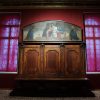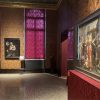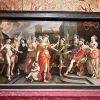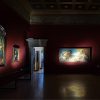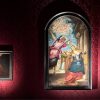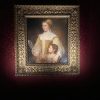From 1615 on, in the atmosphere of the Palazzo Ducale had been offered for public enjoyment a set of paintings formerly owned by the Doge’s Domenico Grimani and upon his death purchased by la Serenissima Repubblica.
Easel Paintings of Flemish Origin, not relevant to the host venue, but becoming in a short time, a permanent presence in the halls of the Palazzo. Marco Boschini referred to these paintings when, in his Venice ‘’pictorial’’ guide in 1664, he listed fifteen little paintings by Civetta (Herri met de Bles) seen in the corridor that leads to the Sala del Consiglio dei Dieci along with a Santa Liberata tryptich, the Martirio di Santa Liberata by Jheronimus Bosch. Confirmation came by Anton Maria Zanetti, when in 1773 he reiterated the presence in the Palazzo of the fifteen paintings seen a century before by Boschini.
Zanetti specified that they were eight landscapes in the ancient manner, a triptych and four compositions “with bizarre inventions” attributed to Civetta, exhibited from 1771 in the hall of Tre Capi del Consiglio dei X, along with the triptych of the Santa Liberata.
During the last Century seventies, an attempt was made to restore this tradition by placing together with la Sala dei Tre Capi also the Sala del Magistrato alle Leggi to the exhibition of that original nucleus of paintings still present in the Palazzo, as the panel paintings of Jheronimus Bosch, today exhibited in the Gallerie dell’Accademia di Venezia placed alongside others from different origins.The current rearrangement of the Sala della Quarantia Criminale, Sala dei Cuoi and Sala del Magistrato alle Leggi fits into this tradition together with ‘’institutional’’ decorative apparatus and other easel paintings from private collections.
In reference to the secular presence of Flemish paintings in the Palazzo, it was decided to reserve the Sala dei Cuoi for the sole exhibition of Flemish works, among which there is the only survivor of those offered for public use in the Palazzo from 1615: the apocalyptic vision already attributed to Civetta and today more appropriately attributed to an anonymous follower of Bosch. Adjacent there is a selection of fascinating 16th-century Flemish paintings by Maerten de Vos, Quentin Metsys and Frans Floris.
In the other rooms are exhibited masterpieces by Giovanni Bellini, Titian, Jacopo Tintoretto and Giambattista Tiepolo, absolute masters of Venetian art, as well as Anthony van Dyck, who had the Venetian painting among his most fruitful inspirations, and Artemisia Gentileschi, the “heroine” painter of the history of Italian art of the seventeenth century, who lived for three years in Venice.
In collaboration with
Venice International Foundation
